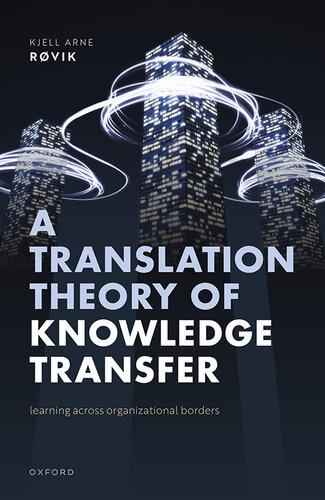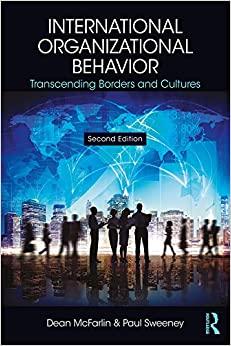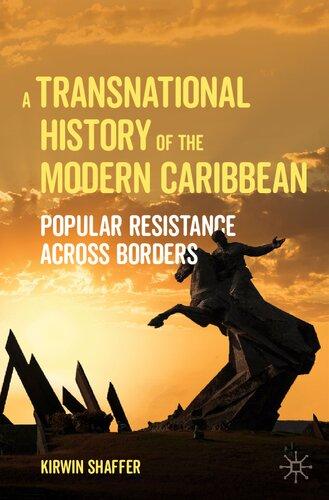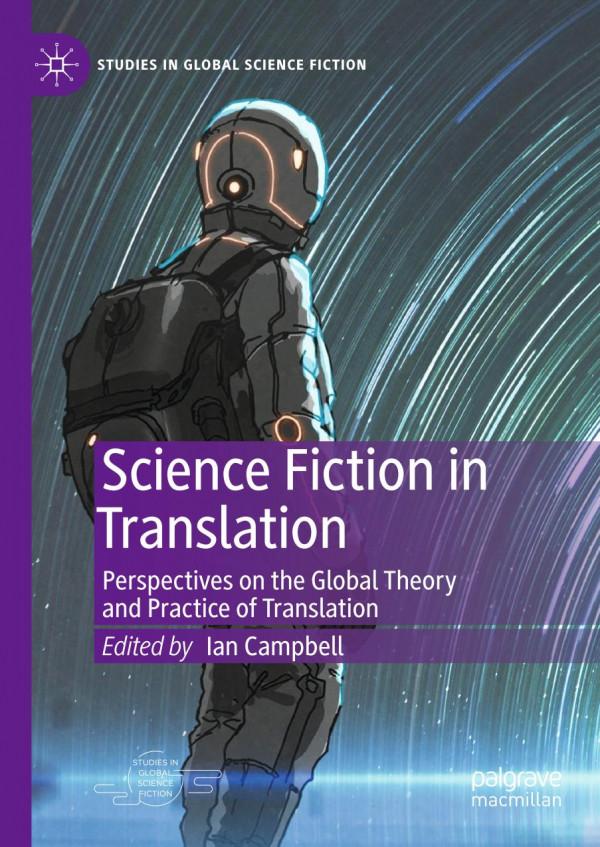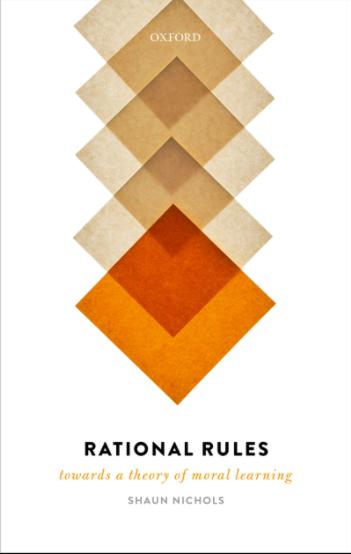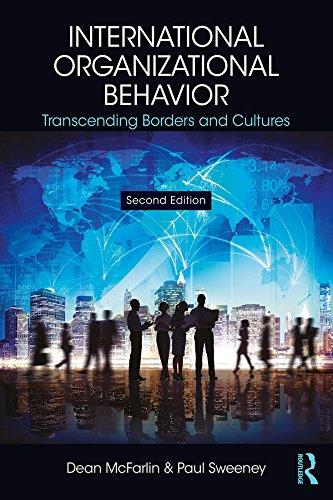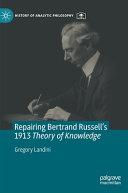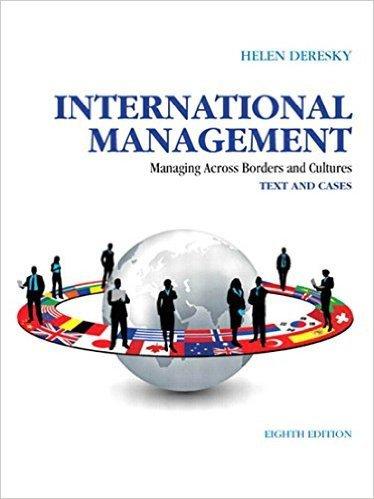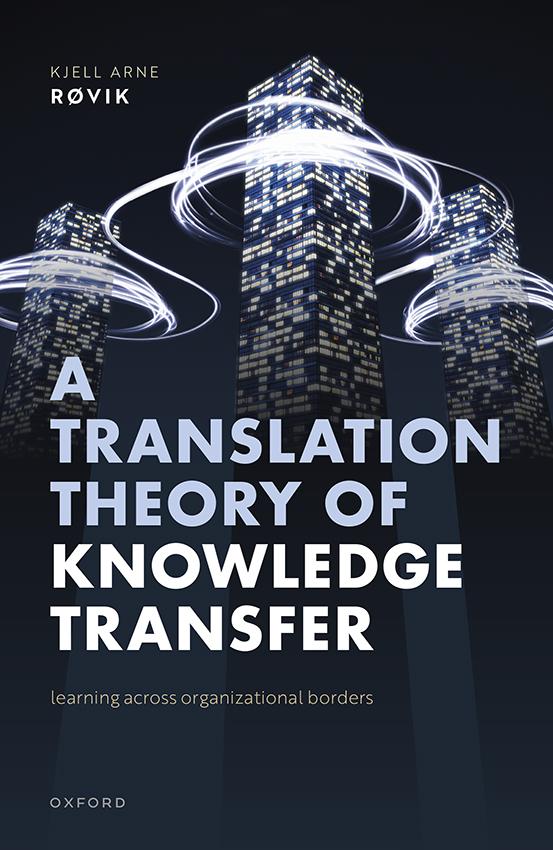A Translation Theory of Knowledge Transfer
Learning across OrganizationalBorders
Kjell Arne Røvik
Great Clarendon Street, Oxford, OX2 6DP, United Kingdom
Oxford University Press is a department of the University of Oxford. It furthers the University’s objective of excellence in research, scholarship, and education by publishing worldwide. Oxford is a registered trade mark of Oxford University Press in the UK and in certain other countries
© Kjell Arne Røvik
2023
The moral rights of the author have been asserted
All rights reserved. No part of this publication may be reproduced, stored in a retrieval system, or transmitted, in any form or by any means, without the prior permission in writing of Oxford University Press, or as expressly permitted by law, by licence or under terms agreed with the appropriate reprographics rights organization. Enquiries concerning reproduction outside the scope of the above should be sent to the Rights Department, Oxford University Press, at the address above
You must not circulate this work in any other form and you must impose this same condition on any acquirer
Published in the United States of America by Oxford University Press 198 Madison Avenue, New York, NY 10016, United States of America
British Library Cataloguing in Publication Data
Data available
Library of Congress Control Number: 2022950958
ISBN 978–0–19–883236–2
DOI: 10.1093/oso/9780198832362.001.0001
Printed and bound in the UK by Clays Ltd, Elcograf S.p.A.
Links to third party websites are provided by Oxford in good faith and for information only. Oxford disclaims any responsibility for the materials contained in any third party website referenced in this work.
Preface
An obvious but often downplayed point in the research literature is that the antecedent of innovations in organizations is the capacity to imitate and learn from other organizations. So, what is the content of this capacity? Why do some organizations often succeed while others often fail to transfer and exploit knowledge from other organizations? These are the key questions that will be highlighted and answered throughout this book. During the last four decades, much empirical research and theorizing efforts have been undertaken to improve our understanding of these knowledge transfer puzzles. This book develops a fresh reframing and a new theory of the subject. It is a theory that has the potential to help us better understand and explain variations in knowledge transfer successes across organizational borders. The theory conceptualizes knowledge transfer between organizations as acts of translations, resembling the translation of language and texts.
I have attempted to make transparent in the book the step-bystep processes through which this new theory has been generated— from the first step, which is a review of the extensive existing literature on the subject, via the introduction and use of metaphors and insights extracted from two external domains of translation studies, and to the generation of an inventory of more precise arguments and propositions that constitute the translation theory of knowledge transfer.
The theory that is outlined should be conceived of as a ceiling that I do hope can serve as a floor for other researchers. It should be
interpreted, criticized, inspire empirical research, be tested and refined—and become the source to new insights.
I am grateful for comments on the book proposal from three anonymous OUP reviewers and for comments on earlier drafts from Hege Andersen, Bjørn Tore Blindheim, Joep Cornelissen, Barbara Czarniawska, Hanne Gabrielsen, Gunnar Gjelstrup, Hanne Foss Hansen, Tor Hernes, Frank Holen, Erik Juel, Hanne Kathrine Krogstrup, Dag Øyvind Madsen, Søren Obed Madsen, Turid Moldenæs, Nanna Møller Mortensen, Tor Paulson, Hilde Marie Pettersen, Trish Reay, David Strang, and Eleanor Westney. Their comments have clearly added to the quality of this work. I offer a special thanks to James Morrison for providing me with his excellent editing service. Finally, I express my admiration and thanks to the two most important girls in my life—my wife Heidi and my daughter, Regine—for still providing me with discussions, ideas, caring, and love.
Contents
ListofFigures
ListofTables
1. Knowledge Transfer and the Quest for the X Factor
I. THE STATE OF THE ART
2. What We Do and Do Not Know: A Review of the Knowledge Transfer Literature
II. IN SEARCH OF A NEW THEORY
3. Antecedents of a Translation Theory of Knowledge Transfer
III. THE THEORY
4. Reframing Knowledge Transfer as Acts of Translations
5. Revealing the Rules of Knowledge Translation
6. Reimagining That Translators and Translations Make a Difference
IV. IMPLICATIONS FOR KNOWLEDGE TRANSFER PRACTICES
7. Translation Competence: Implications for Knowledge Transfer Practices
References
Index
1 Knowledge Transfer and the Quest for the X Factor
Introduction
This book zooms in on the challenges of transferring and sharing knowledge across organizational borders. Knowledge transfer refers to the processes through which actors and units exchange, receive, and are influenced by the experience and knowledge of others, and it can manifest itself through changes in the knowledge bases or performance of recipients (Argote et al., 2000; van Wijk et al., 2008). Three observations and one main ambition have inspired this book. The first observation is the increased importance of effective knowledge transfer for a wide range of critical organizational success variables. The second is the observation (actually, a number of observations) that effective knowledge transfer is very challenging; such processes sometimes succeed, but they frequently fail. The third observation is that despite extensive research efforts, we still lack theories with high explanatory power to account for the huge variations in knowledge transfer successes, as well as researchbased means to guide actors involved in knowledge transfer processes.
Partly in response to these observations, the aim of this book is to outline a new theory that (re)conceptualizes knowledge transfer between organizations as acts of translation, resembling the translation of language and texts. This theory has the potential to improve our understanding of why knowledge transfer processes sometimes succeed and sometimes fail, and also has the potential to inform practitioners involved in knowledge transfers about appropriate actions. The theory points towards translation competence as the key organizational capacity required in knowledge transfers.
Let us first take a closer look at the three above-mentioned observations.
Knowledge transfer and organizational success
The capacity of an organization to transfer and exploit knowledge from other organizations is a key to its competitiveness, progress, and survival. This insight sheds light on the complex relation between imitation and innovation (Strang and Meyer, 1993). Although society celebrates the innovating organization (“the lone genius”) and its inventions (Sevòn, 1996; Perry-Smith et al., 2015), newness and an organization’s capacity to innovate are, in fact, often linked directly to its capacity to imitate and learn from other organizations’ practices and ideas.
Knowledge transfer capacity affects a number of critical organizational performance variables. Many studies have found that the capacity to identify, transfer, and exploit knowledge from other organizations is an antecedent and key input for a focal organization’s capacity to innovate and improve performances (Cohen and Levinthal, 1990; Song et al., 2018). For example, it has been shown that knowledge search and transfer capacity has been a
prerequisite for focal organizations’ development of new technology (Santoro et al., 2017; Flor et al., 2018), new products (Alexander and Childe, 2013), new patents (Zeng et al., 2019), and has led to improved overall organizational performance, such as increased returns on investments (Patel, et al., 2015) and sales growth (Kohtamäki et al., 2019). The connection between knowledge transfer and competitiveness is often illustrated with reference to the expansion of large multinational corporations, a phenomenon that largely reflects how knowledge can be transferred relatively smoothly across borders within such organizations, which regularly creates huge competitive advantages (Westney, 1993; Zander and Kogut, 1995; Jensen and Szulanski, 2004; Riusala and Smale, 2007).
Other studies have indicated that knowledge transfer capacity even affects organizational survival rates. For example, Agarwal et al. (2004) found that among entrepreneurial ventures, spin-out organizations (entrepreneurial ventures of ex-employees in parent organizations) had an edge over other entrants in terms of survival, which reflected the existence of corridors of knowledge transfers from the parent organizations to the spin-outs. Winter et al. (2012) studied a group of franchising organizations and the extent to which they were able to transfer and replicate exactly knowledge from their parent organization (the franchisor) about the franchising concept. The authors found that the franchising organizations that most accurately transferred and replicated the franchising concept had significantly higher chances of staying in business and surviving than those franchisees that were less accurate. Tavares (2020) studied organizational survival among 24.163 newly created establishments (spin-outs) from preestablished parent firms in Portugal from 2003 to 2008. The parent firms had the option of transferring workers from the parent organization to the new establishments. The study showed a significantly higher survival rate among establishments with high versus establishments with low levels of employees recruited from the parent organizations. Tavares interpreted the
variations in survival rates as being mostly caused by variations in knowledge transfer effectiveness. Firm knowledge, which was embodied in the parent firm workers, was effectively transferred to the new establishments through internal recruitment of workers from parent firm, thus increasing the establishments’ survival chances. Ingram and Baum (1997) studied the effects of chain affiliation on individual hotels in the Manhattan hotel industry from 1890 to 1980. They found that, under most circumstances, chain affiliation improved the survival chances for the individual hotels. The researchers ascribed much of this survival effect to effective transfer of operating knowledge from the chain to the affiliated component hotels.
Relevance beyond business organizations
Most of the knowledge transfer literature stems from studies of market-exposed business-firms seeking competitive advantages. In a literature review of knowledge transfer and organizational learning with relevance to public sector organizations, Rashman et al. (2009) concluded that “there is an over-reliance on the private sector as the principal source of theoretical understanding and empirical research” and “a tendency to assume by default that the context was the private sector firm, and that ‘the firm’ is synonymous with organization” (pp. 486−487). However, knowledge transfers across various borders are decisive for most types of organizations and have impacts on a wide range of outcome variables, beyond business firms and their competitive edge. For example, knowledge transfer also includes the transfer of models of political organizing between nation-states. Efforts to promote and spread democracy to countries where models and practices of democracy are insufficient or absent can be conceived of as a giant knowledge transfer project. These efforts are premised on a strong notion that democracy is the
preeminent form of political organizing and governance of nationstates (Ober, 2008). Although the spread of practices and models of democracy has a long history that can be traced back to the American Revolution of 1776 and the French Revolution of 1789, the period since the late 1960s has seen a dramatic increase in attempts to spread this model to the world’s nation-states (Whitehead, 1996; O’Loughlin et al., 1998). The so-called “third wave” of democratization began in Sothern Europe in the early 1970s (Gunther et al., 1995) and diffused to Latin America in the 1980s (Hagopian and Mainwaring, 2005). The end of the Cold War in 1989 and the disintegration of former communist Eastern Europe saw the start of extensive attempts to export democracy to East European countries (Schraeder, 2003). These processes were also propelled by the European Union, which demanded democratic governance in exchange for the East European countries becoming members of the European Union (EU) (Olsen, 2002).
However, spreading democracy with the aim of reproducing this ideal in institutions and governance practices in nation-states—often ones that have meager democratic traditions—is probably among the most challenging knowledge transfer processes one can imagine.
In addition to political organizing, we also have observations of the importance of transfer and translations of models of administrative organizing for the shaping of nations-states’ public administration. A seminal work here is Eleanor Westney’s study of the dramatic transformation of Japan’s public administration during the Meiji period (1868−1912) (Westney, 1987). These changes reflected the Meiji leaders’ ambition to modernize the country’s public administration, inspired by foreign models and as part of a national project that aimed to put Japan on equal footing with the West. The Meiji agents systematically collected information about the practices and the principles of organizing the postal system, the police, and the press in various Western countries. Some features of the Western models were selected and then creatively mixed with
Japanese bureaucratic traditions. These knowledge—and translation —processes materialized in a new and radically transformed public administration that observers have assessed as being even more modern than that of its Western counterparts.
Today, many public sector organizations base the development of their services on benchmarks from other comparable organizations and on transferred knowledge about good or best practices. An example is the public education sector, which during the past 25 years has experienced a rationalized and very powerful knowledge transfer turn that aims to improve children and students’ learning performances and achievements. Initiated and coordinated by strong international actors such as the Organisation for Economic Cooperation and Development (OECD), the EU, and the IEA (International Association for the Evaluation of Educational Achievements), the rationalized knowledge management system comprises large-scale organizing and routinization of the production, distribution, and implementation of knowledge about effective educational practices (Røvik, 2014). This system entails regular international surveys (such as the Pisa test) that offer big data on matters such as the learning environment and students’ performances in various subjects. It also includes the use of clearing houses, which are institutions established for providing evidencebased information about the effects of education programs, policies, and interventions, and have been founded in many Western countries over the last three decades (Slavin, 2008). Clearing houses are designed to identify good educational practices and to compile, analyze, synthesize, shape, and disseminate evidence-based knowledge—especially to professionals, politicians, and the media. The core idea—that public services and practices must be based on identified, gathered, analyzed, and disseminated knowledge about evidenced best practices—is now widespread and represented in most public sectors, such as healthcare (Andersen et al., 2014),
social care (Macdonald, 2000), public transportation (Terry, 2000), and urban policy (Harrison, 2000).
The architecture of knowledge transfers
How can knowledge that is developed and used within certain organizational contexts be moved to other organizational contexts and lead to desired organizational outcomes, such as increased competitiveness and survival rates in business firms, as well as more democratic governed nation-states and more modern and effective public administrations? Knowledge transfer is an eclectic concept that covers a lot of variation. However, such variations are all versions of an underlying common knowledge transfer architecture that contains five main elements. These are (a) source organizational context, (b) practices and knowledge to be transferred, (c) borders (or barriers) between source and recipient units, (d) recipient organizational context, and (e) mediators. These elements, and how they are combined, vary greatly between different contexts and knowledge transfer processes. For example, sources and recipients can be separate and independent organizations, as well as separate but internal units belonging to the same organization. Further, the concept of borders entails all kinds of knowledge flow hindrances between sources and recipients. Knowledge transfer always involves some kinds of border crossing and friction. Borders are sometimes minor, such as in processes of intraorganizational knowledge sharing among workers co-located in one organizational unit (Tell et al., 2017). On the other hand, interorganizational knowledge transfers between independent organizations often involve crossing far more challenging borders. The barring effects may increase with increased geographical, cultural, and institutional distance between sources and recipients.
Another element that has significant empirical variance is mediators; that is, those actors involved in transferring knowledge from sources to recipients. Knowledge transfer can be indirect, which means that it is carried out by mediators who are distanced both from the source and the recipient organization (SahlinAndersson and Engwall, 2002). Among the typical indirect mediators are consultants (Ostroff, 1999; Wright, 2019), business media (Barros and Rüling, 2019), academics (Grandi and Grimaldi, 2005), and management gurus (Collins, 2019). For example, authors of popular management books are often distant mediators who attempt to convey success formulas from certain organizations to a broad audience of potential recipients (Furusten 1999). Numerous books and articles, most of them published in the 1970s and 1980s, urge Western organizations to learn from Japanese practices of management and organizing (Drucker, 1971; Ouchi, 1981; Pascale and Athos, 1981), while other examples include biographies about famous leaders and their management principles (Novak, 1986; Isaacson, 2011).
Direct knowledge transfer means that source-based and recipientbased actors are more involved in the mediation processes. A wellknown example came from the setup of Japanese companies’ subsidiaries in the United States in the 1980s (Froin et al., 1999). In some of these cases, the Japanese strategy was to reproduce their management system and production technology with great exactitude in their American transplants (Pil and MacDuffie, 1999). To implement this strategy, the Japanese parent organizations staffed the subsidiaries with a high proportion of Japanese managers and workers who interacted directly with the American employees and instructed them about the parent company’s production system (Adler, 1999; Westney and Piekkari, 2020). This often involved linguistically constrained contexts, so the transfer of knowledge was frequently conducted through nonverbal communication, such as showing work movements and real-time demonstrations of how
machines and tools should be used (Sunaoshi et al., 2005). The intense effort of direct knowledge transfer knowledge from the Japanese parent organizations is undoubtedly an important factor that explains the successes of many of their subsidiaries in the United States throughout the 1980s and 1990s, especially within the motor vehicle industry (Helper et al., 1999).
The above examples show that certain knowledge transfers vary greatly within the overall common architecture of five elements and can thereby offer very different conditions for transfer processes.
Transfer successes and failures
While knowledge transfers across organizational borders are extremely important for organizations’ healthiness, they are not at all straightforward processes with predictable outcomes. Two keywords variationsand complexities—sum up insights from a large number of observations of knowledge transfer processes. There are many obstacles to effective knowledge transfer, which can come to expression in huge variations in processes and outcomes. In fact, knowledge transfer initiatives often succeed, such as when knowledge is transferred smoothly from a source unit and fully implemented in a recipient unit, sometimes leading to performance improvements and long-lasting competitive advantages. One of the best known, thoroughly researched, and frequently cited knowledge transfer successes is related to the establishment of the abovementioned Japanese subsidiaries in the United States during the 1970s and 1980s (Florida and Kenney, 1991; Westney and Piekkary, 2020). However, a main finding from empirical studies is the huge variations in processes and outcomes of knowledge transfers across organizational borders (Gupta and Govindarajan, 1994; 2000; Szulanski, 1996; Davenport et al., 1998; Alavi and Leidner, 1999; 2001; Dixon, 2000; Bouncken and Kraus, 2013; Oyemomi et al.,
2016; Tell et al., 2017). For example, Davenport et al. (1998) studied 31 knowledge transfer projects in 24 large organizations from various industries and based in different countries. They defined and measured transfers success and failure in relation to four success indicators: (1) growth in the resources attached to the project (people, money, etc.); (2) growth in the volume of knowledge gained and used; (3) survival, which is the likelihood that the project would survive and become a (more) enduring organizational initiative; and (4) evidence of financial return stemming from the transferred knowledge. The researchers classified 18 of the 31 projects as successful. Almost all of the 18 knowledge transfer projects that were classified as successes fulfilled all four criteria. In some of these cases, the knowledge transfers led to major organizational transformations. Five of the 31 projects were classified as failures, while eight projects were at such an early phase that their outcomes could not be evaluated. Another example: Tidd and Thuriaux-Alemán (2016) studied the transfer, adoption, and effectiveness of a research-based innovation management—practices in a sample of 292 organizational units in different industries and countries. Overall, they found significant variations in adoption and usage rates. They also found that usage of the innovation management practices was associated with positive innovation outcomes.
However, knowledge transfer initiatives frequently fail. There are six common indications of transfer problems and failures in organizations. First, such problems often manifest themselves as deficient information in focal (adopting) organizations about potential useful knowledge residing in other organizations. Sometimes an organization can identify a desired practice in another organization, but is not able to fully understand and codify it (Mansfield, 1985; Strang and Still, 2006). This is a serious challenge for knowledge transfers, especially in cases where the desired practice is premised on context-specific and tacit knowledge
(Dhanaraj et al., 2004). The less an adopting organization understands the logic behind a well-functioning practice in another organization, the more challenging it becomes to recreate the practice at home.
The second expression of problems is cases where transfer of knowledge is not initiated, because organizations sometimes do not even discover eminent practices and knowledge that is already present in their own organization. For example, in 1992 the American Productivity and Quality Center (APQR) established the International Benchmarking Clearinghouse (IBM), which is an organization designed to search for and transfer global best practices to their prominent and successful member organizations. However, while searching for global best practices outside their own walls, the member organizations—which themselves conducted the benchmarking processes in close cooperation with IBM—were surprised to discover good practices and their appurtenant knowledge base within their own organizations. The discovery was surprising because this had been a hidden secret for the leaders.
O’Dell and Grayson (1998), who analyzed this case, summed up the lesson succinctly as follows: “The grass was greener in their own back yard, and they did not even know it” (p. 5).
A third indication of knowledge transfer problems comes to expression in slow or reduced speed of transfer processes (Davidson, 1980; Mansfield and Romeo, 1980). Identified and desired knowledge sometimes move slowly across organizational borders, and even among members within an organizational unit (Zander and Kogut, 1995; Prusak, 1997). In a comparative study of in-house knowledge transfer among a group of IBM member organizations, Szulanski (1994; 2000) provided evidence for this argument. He found that even among the best organizations, it took an average of 27 months to transfer acknowledged and desired knowledge from a part in the organization where it was practiced to other parts of the organization. Such findings also indicate that the
notion of high-speed knowledge transfer within organizations (for example, within multinational corporations), but not between them, needs to be problematized and modified.
A fourth manifestation of transfer problems is instances of missing implementation of transferred knowledge. New knowledge is sometimes discovered, transferred, and even formally adopted by a recipient unit, but then not materialized in new practices (Drago, 1988; Szulanski, 2000; Griffith et al., 2005; Li and Hsieh, 2009). Studies of the development, transfer, and usage of innovations within healthcare (meaning evidenced new knowledge) provide illuminating examples. From healthcare research comes a rich and almost constant supply of new, evidenced knowledge about what should be considered best practices in healthcare. Every year, approximately 10,000 new randomized trials are included in MEDLINE (Chassin, 1998), which is the bibliographic database of life sciences and biomedical information. However, studies have revealed a divide between the supply of evidenced knowledge and practice in healthcare. In the Netherlands and the United States, approximately 30–40 percent of patients are not treated according to present scientific evidence (Schuster et al., 1998; Grol, 2001), while approximately 20–25 percent of healthcare practices are assessed as unnecessary and/or as potentially harmful (Grol and Grimshaw, 2003). A fascinating aspect of these insights from the healthcare sector is that the professionals do not change their healthcare practices according to available new knowledge, even though there are strong professional norms among healthcare personnel to act rationally and be open-minded to new evidence-based knowledge in their fields (Ferlie et al., 2005). Such observations of gaps between available knowledge and practice correspond with similar observations in neo-institutional organization theory about transferred new knowledge and ideas that lead to change of talk in the recipient organization, but leave core practices unchanged (Meyer and Rowan, 1977; Brunsson, 1989; Westphal and Zajac,
2001; Bromley and Powell, 2012; Snellman, 2012; Stål and Corvellec, 2018). Neo-institutional scholars have theorized the logic behind such decoupling as one of seeking legitimacy in broad institutional environments by formally adopting new ideas, thus signaling adherence to widely admired values, such as science, evidence, and progress, while simultaneously seeking effectiveness and efficiency by protecting in-house existing and complex practices that work well from being changed in accordance with the externally legitimized ideas (Bromley and Powell, 2012; Boxenbaum and Jonsson, 2017).
A fifth indication of transfer problems stems from observations of inappropriate transformations of the transferred practices/knowledge throughout the transfer processes. Desired practices and the appurtenant knowledge about them are sometimes transformed during the transfer processes in such ways that they do not work in the recipient units. This can occur because the transfer process has led to transformations that have destroyed fine-tuned inherent causal mechanisms. As mentioned above, Winter et al.’s (2012) study of the spread of a francizing organization illustrates this point. They found that the units that most accurately replicated the actual franchise concept had significantly higher chances of succeeding, in the sense of staying in business, than those units that were less accurate and transformed the concept. In another study, Blakely et al. (1987) researched the dissemination and adoption of seven social innovations programs within the education sector and the criminal justice sector. They found that the more the adopting organization modified and changed the original programs, the less likely it was that they would work as intended. These findings correspond with views known from the fidelity camp (Bauman et al., 1991) and their arguments for the need to remain true to the original, or prototype, when transferring knowledge across organizational borders. According to the proponents of high fidelity, altering evidenced knowledge such as a social improvement program is a transfer
failure that reduces its effectiveness (Calsyn et al., 1977; Forgatch and DeGarmo, 2011).
The sixth, and probably the ultimate indication of knowledge transfer failure, is cases where new knowledge is transferred to a recipient organization and then implemented and materialized in new organizational practices but does not work and leads to gaps between expected and actual results (Acemoglu et al., 2008; Askim et al., 2008; Røvik, 2011; Pyun and Lallemand, 2014). Although such outcomes may sometimes be caused by the above-mentioned mechanism of low-fidelity transfer, this is only one of several possible reasons why implemented new knowledge does not work. In fact, the opposite argument is frequently raised; that is, that transfer failures sometimes are expressions of too little adaptations of what is transferred to the context of the recipient organization (Cummings and Teng, 2003). Anyway, the research literature contains numerous observations and analyses of instances where new and implemented knowledge fails to work in practice (Pressman and Wildavsky, 1973; Elmore, 1979; Xue et al., 2005; Skogan, 2008; Ren, 2019).
Simple models—complex processes
As illustrated above, there are huge variations in processes and outcomes of knowledge transfer efforts. Even more challenging than revealing such variations is understanding and explaining why they occur. Variations in outcomes often reflect complexities in transfer processes that are very hard to trace, theorize, and model. This insight stands in contrast to widely held views that knowledge transfers are rather simple processes. As stated by Szulanski (2000), current conceptions of knowledge transfers, which also dominate research, portray such processes as rather straightforward, instantaneous, and almost costless. A corresponding notion is that
difficulties in knowledge transfers are deviations from what is standard, normal, and expected.
Where do such notions stem from? An important source is the signal–transmission metaphor. This is somewhat surprising because this metaphor, which is imported from information theory, has become an underlying model in most research on knowledge transfer across organizational borders. This theory, which was initially formulated by Claude Shannon (1948) and Shannon and Warren Weaver (1949), and detailed and refined in many later works (Cole, 1993; Pierce, 2012), depicts communication between units as mainly one-way processes and conceptualizes the basic elements in such processes as source (sender), channel, message, noise, and recipient. Shannon and Weaver’s theory has informed many research fields, primarily studies of signal transference in technical systems, but also biology and life science (Cobb, 2015) and the social sciences (Leydesdorff, 2021). Within organization theory, it has been widely used to conceptualize and structure knowledge transfer studies, although often without referring explicitly to Shannon and Weaver. However, the signal transmission metaphor also has disadvantages, in that it limits the conceptualization of the complexities of organizational border-crossing knowledge transfer processes. The technological context within which Shannon and Weaver developed their ideas—which was telephone companies and concern with the engineering aspects of electronic communication— has made its mark on the theory, in the sense that it is more suitable for understanding electric signal transmission than human communication. Within this theory, knowledge transfers are mainly conceptualized as one-way directional processes with an active source and sender (that is, a central broadcasting point that initiates and adds all the power to the process) and a passive recipient. However, this is an overly simple conceptualization of knowledge transfer across organizational borders. For example, it does not account for insights from knowledge transfer research and especially
studies of absorptive capacity, which show that recipient organizations—and not the source—are often the active parts that search for new knowledge and initiate knowledge transfer processes (Cohen and Levinthal, 1989; 1990; Song et al., 2018). Further, the insight that recipients are not passive receivers, but instead are interpretative systems that may reject and/or transform received knowledge, also complicates simple signal transmission images of knowledge transfer processes. Another feature of the signal transmission model is the notion of high-speed and almost automatized one-directional transfer processes from source to recipient. However, several knowledge transfer studies depict such processes as much more messy, time-consuming (Westney, 1987), and laborious (Szulanski, 1996; 2000) for the involved organizations.
There are many antecedents to the complexities that lead knowledge transfer processes to deviate severely from simple images of signal transmission models. One is the coordination challenges. A knowledge transfer across organizational borders is often better depicted as a complex ecology of loosely organized actors, often with divergent interests and aims, than as straightforward one-way signal transmission processes. Thus, knowledge transfers usually comprise many and often relatively loosely coordinated and time-consuming processes. Such processes are often driven by various and shifting groups of actors, who may be involved in different phases of the transfer. For example, some actors can be source-based and mainly involved in early phases, while others are recipient-based and involved in later stages. Increasing the number of involved actors increases the potential for a transfer logic resembling the “whispering down the lane” game, which increases the likelihood that the transferred knowledge will be distorted (Andersen and Røvik, 2015).
A second source of complexity is knowledgeaccesschallenges. An organization’s motivation to acquire knowledge from external sources is usually premised on observations of other organizations’
successful achievements, such as their high-quality products and/or high returns. However, a classic challenge that is pertinent to such situations is revealing the factors and trajectories underlying other organizations’ achievements; that is, the knowledge and practices that generate the observed results (Røvik, 2014). This is sometimes rather easy, but can often be very difficult, especially when the task is to understand and recreate the causes behind the good and desired practices (Argote and Ingram, 2000). The secrets of the winners are usually hard to trace (Røvik, 2002). This often reflects the corresponding (third) challenge of divergent interests: simply, what a knowledge seeker and potential recipient organization wants to know about a desired practice, a potential source organization may want to protect and keep as a secret (Granstrand, 2000). In addition, potential recipients’ problems with gaining knowledge sometimes reflect that even source-based actors involved in the performance of the desired practice are not able themselves to fully overview, understand, and communicate in precise terms the decisive factors that account for the quality of the practice (Lippman and Rumelt, 1982). Anyway, knowledge access problems are a defining feature of knowledge transfer processes and a stable source of complications, such as slow speed of the transfer, and, correspondingly, to stable high chances for spread of low-fidelity and distorted versions of desired practices.
Difficulties—or “stickiness” (von Hippel, 1994; Szulanski, 1996; 2000; Szulanski and Capetta, 2003)—such as those mentioned above, are intrinsic parts of knowledge transfer processes. They can be identified, analyzed, and to some extent handled, but never be totally avoided. These are important reasons why knowledge transfer processes frequently deviate from simple images of signal transmission models.
In addition to the dominating signal transmission images, there is also another important source for the notion of relatively straightforward knowledge transfer processes. These are the widely
held popular images that knowledge transfer is becoming increasingly simple. Such images are often premised on arguments about an ongoing communication revolution, with social media and other communication technologies inevitably and interactively connecting people, organizations, and ideas in intense information flows, leading to an almost unhindered and rapid global distribution and adoption of knowledge and best practices (Santoro and Bierly, 2006; Turkina and Van Assche, 2018). However, numerous observations have indicated that such flows still involve a great deal of friction. For example, many knowledge transfer studies have shown that the most valuable knowledge—that is, knowledge that constitutes lasting competitive advantages—is often almost nonmigratory in nature and is the hardest type of knowledge to transfer and exploit (Hu, 1995; Nonaka and Takeuchi, 1995). Such observations highlight an important point: to be able to understand and explain variations in outcomes of knowledge transfer processes, one must first acknowledge that complexity is an inherent feature of such processes (Szulanski, 2002).
